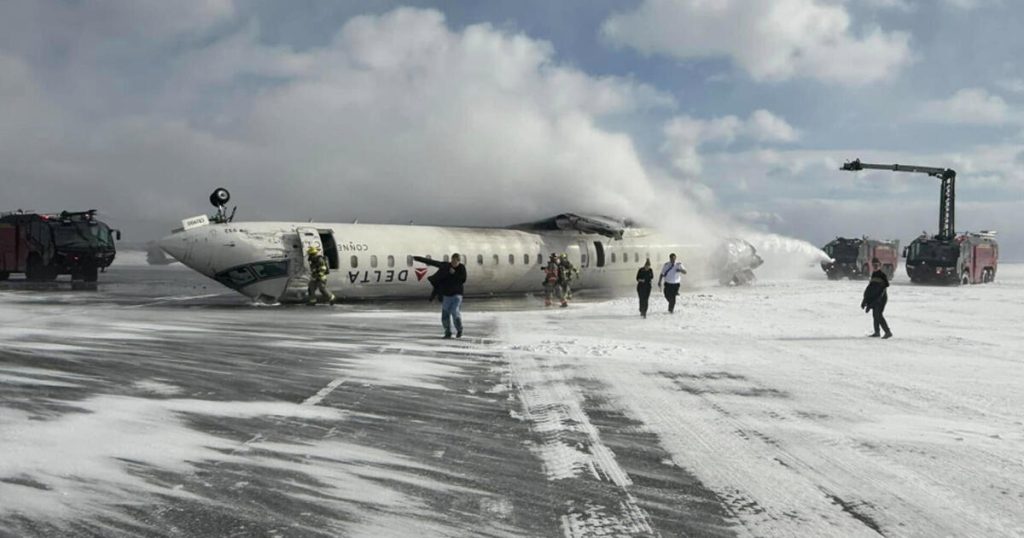A Delta Air Lines flight encountered a serious incident upon landing at Toronto Pearson International Airport, resulting in injuries to 21 people. Flight 4819, which had departed from Minneapolis-St. Paul International Airport, flipped upside down during the landing amid adverse winter conditions. Currently, the investigation is underway as officials gather information regarding the crash that occurred shortly after 1:15 p.m. CST on Monday.
| Article Subheadings |
|---|
| 1) Details of the Incident Unfold |
| 2) Immediate Response from Emergency Services |
| 3) Injuries Sustained by Passengers |
| 4) Weather Conditions at the Time of Landing |
| 5) Investigation and Future Implications |
Details of the Incident Unfold
According to reports from officials, Delta Air Lines Flight 4819 encountered a serious mishap as it attempted to land at Toronto Pearson International Airport. The flight, which had departed from Minneapolis-St. Paul International Airport, was carrying 80 individuals, including four crew members and 76 passengers. The incident occurred at approximately 1:15 p.m. CST. Upon landing, the aircraft flipped upside down due to what appeared to be complications arising from wintry weather conditions prevailing at the time.
Deborah Flint, the president and CEO of Toronto Pearson International Airport, confirmed that 22 passengers on board were Canadians, while the remaining travelers represented various nationalities. Flint noted that the airport’s emergency workers exhibited a detailed and efficient response, successfully evacuating all passengers within minutes of the incident.
Immediate Response from Emergency Services
In light of the unfolding situation, emergency responders reached the site swiftly, ensuring the safety of passengers and crew members aboard the aircraft. Official statements from Flint praised the actions of the emergency workers at the airport, emphasizing that their rapid response was crucial to managing the aftermath of the incident. Emergency services employed a well-coordinated strategy for assessing the situation, securing the area, and providing aid to those injured.
Witnesses described a scene filled with urgency and determination as first responders acted diligently to assist those affected. The prompt arrival of paramedics ensured that medical attention was available to all passengers, with special focus on the seriously injured individuals. The effectiveness of their emergency protocols was highlighted as a defining factor in handling the situation adequately.
Injuries Sustained by Passengers
As a result of the crash landing, a total of 21 individuals sustained injuries of varying severity. Two passengers remain hospitalized, with reports indicating that one adult female in her 40s and one adult male in his 60s were critically injured. Both were airlifted to the hospital for emergency care, underscoring the seriousness of their conditions.
Notably, initial reports included a child classified as critically injured. However, the Hospital for Sick Children later updated this classification, confirming that the child was now in stable condition. The remaining injured parties suffered various degrees of minor to moderate injuries. This spectrum of injuries has prompted inquiries into the aircraft’s safety protocols and overall response measures to protect passengers during such emergencies.
Weather Conditions at the Time of Landing
Meteorological conditions at the time of the incident were reportedly challenging. Wind gusts of up to 37 mph and blowing snow contributed to decreased visibility, which was recorded at 6 miles. The temperature during the incident was well below freezing, measuring at 17°F.
Airport fire chief Todd Aitken later commented that the runway conditions were primarily dry, and there were no significant crosswinds that could have accounted for the aircraft flipping. These weather factors, combined with the complex nature of landing an aircraft, led officials and investigators to scrutinize the influence of weather on the incident.
Investigation and Future Implications
The Transportation Safety Board of Canada is assuming leadership of the investigation into the crash, with assistance from the National Transportation Safety Board and the Federal Aviation Administration. As this inquiry progresses, transport officials aim to determine the exact causes and contributing factors correlated with the plane’s unusual landing.
In the immediate aftermath of the incident, some runways at Toronto Pearson International Airport have been temporarily closed to facilitate the investigation. Ontario Premier Doug Ford expressed relief over the absence of fatalities, remarking that the provincial authorities remain in close contact with the airport and emergency services to ensure that all necessary assistance is provided. This accident, occurring shortly after several other aviation incidents in the region, highlights the essential need for rigorous safety measures and practices in the aviation industry.
| No. | Key Points |
|---|---|
| 1 | The incident involved Delta Air Lines Flight 4819, which flipped upside down during landing at Toronto Pearson International Airport. |
| 2 | A total of 21 individuals sustained injuries, including two who are critically injured. |
| 3 | Emergency services responded effectively, evacuating passengers within minutes of the crash. |
| 4 | Weather conditions were severe, with low visibility and strong winds affecting aircraft operations. |
| 5 | An official investigation is underway to determine the cause of the incident, with assistance from U.S. authorities. |
Summary
The troubling incident involving Delta Air Lines Flight 4819 underscores the challenges faced by the aviation sector during adverse weather. With investigation proceedings kicking off promptly and emergency services responding with efficiency, the safety of passengers and crew members remained a priority. Authorities are focused on understanding the factors that contributed to the crash, representing an important chapter toward improving aviation safety standards moving forward.
Frequently Asked Questions
Question: What caused the Delta Air Lines plane to flip upside down?
Investigators are assessing various factors, including weather conditions and landing procedures, to understand the circumstances leading to the aircraft flipping during landing.
Question: How many passengers were on board Flight 4819?
The flight was carrying a total of 80 individuals, comprising 76 passengers and four crew members.
Question: What is the status of the investigation into the incident?
The Transportation Safety Board of Canada is leading the investigation with support from U.S. agencies to determine the cause and circumstances of the crash.


